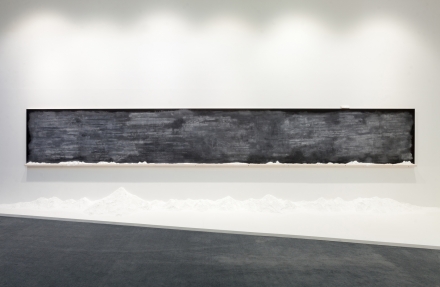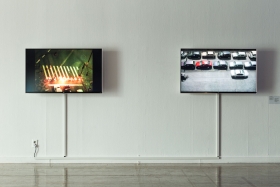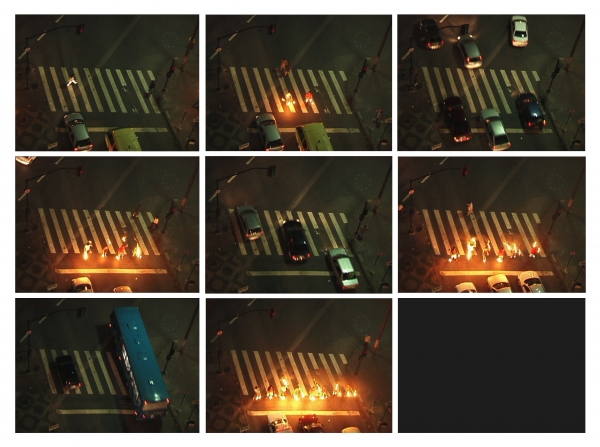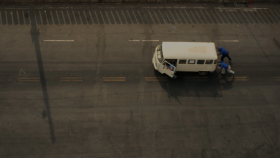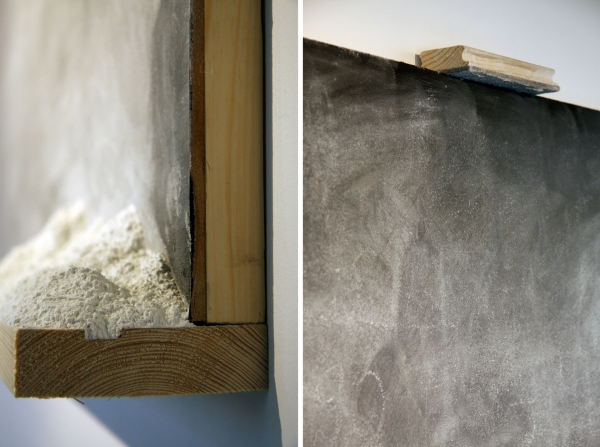Cinthia Marcelle
Leitmotiv, 2011, Video, 16:9, 4 min. 16 sec.
Autom?vel [Automobile], 2012, Video, 16:9, 7 min. 11 sec.
Confronto [Confrontation], 2005, Video, 4:3, 7 min. 50 sec.
Courtesy of the artist and Galeria Vermelho
? Location:?Seosomun Main Building
SOBRE ESTE MESMO MUNDO (THIS SAME WORLD OVER), 2009-2010, Installation, erased blackboard, powder of chalk and eraser, 120 x 840 x 10.2 cm, Courtesy of the artist and Galeria Vermelho
? Location: Buk-Seoul Museum of Art
An empty floor is captured on the screen, and we start to hear the sound of water from somewhere being poured and falling and being washed away. Soon after, from the bottom of the screen, water mixed with suds slowly starts to creep up to soon cover the entire floor. The sound of the water grows gradually louder and brooms suddenly appear from everywhere, sweeping the sudsy water to the middle of the screen. The sound of the water being swept becomes increasingly intense before suddenly stopping, and then the brooms also disappear. Cinthia Marcelle has mostly presented works that focus on the commotion of everyday life, the movement of bodies, and the charm of common materials, and Leitmotiv indeed shows a small event of everyday life transformed into a delightful and poetic work.
In Autom?vel [Automobile], a camera captures cars speeding along a two way street on an ordinary weekday in the middle of a city. An instant later, one side of the road becomes completely blocked and we begin to hear the sound of clamorous horns and cars broken down on the road are emitting smoke. Then we see an image of the drivers and their passengers getting out and slowly pushing their cars; the same situation arises on the opposite side of the road. In the end, all the cars on the road are being pushed by people as day gradually changes to night. Seeing the cars no longer able to run, and drivers forced to get out and push them makes us reconsider the speed of our lives to which we have become accustomed. In addition, the drivers who ultimately become trapped in the dark night as they push their cars forward remind us of the evil Corinthian king Sisyphus who was condemned to hell after his death where he was forced to eternally push a boulder up a steep mountain, and we are compelled to rethink the exact meaning of moving forward.
In Confronto [Confrontation], two people walk onto a crosswalk where the traffic light signals pedestrians to cross, and they begin juggling torches. When the signal changes to let cars through, the jugglers stop and separate to opposite sidewalks, and the cars that had been stopped and waiting, continue on as if nothing had happened. Each time the signal changes, the number of jugglers multiplies, from two to four, to six, and then eight. And when the final eight jugglers continue to juggle even after the signal changes, the quiet cars start honking their horns ever louder; the cars even move in a threatening way as if trying to push through the jugglers. The glow of the torchlight, which becomes brighter as the number of jugglers increases, and the sound of the horns, which grows louder as the jugglers stop moving in line with the signal lights, makes a strong impression, leading us to imagine what may happen when there is a crack in the well-ordered social system.
SOBRE ESTE MESMO MUNDO (THIS SAME WORLD OVER) takes a blackboard—a familiar object used in learning spaces—not as a simple object, but as a world that is written and overwritten, to suggest an extended view on learning. It also questions the world of learning where things are conceived to be discovered and rediscovered through education, based on what has been regarded as true and sure, ultimately proposing another worldview for reconsidering all of this. The horizontally-extended surface of the blackboard bears its traces of inscription and erasure, reminding us of the classes of the past that have now been removed and are absent.
Cinthia Marcelle
b. 1974. Lives and works in S?o Paulo.
Cinthia Marcelle was born 1974 in Belo Horizonte, Brazil. Partner of Kat?sia Filmes, production company dedicated to the creation and research of cinema and art, based in Belo Horizonte. She graduated in fine arts from the Universidade Federal de Minas Gerais, 1997?1999. Her work has been commissioned for significant group exhibitions including the Biennal de la Habana, 2006; Lyon Biennale, 2007; Panorama da Arte Brasileira, S?o Paulo and Madrid, 2007?2008; Bienal de S?o Paulo, 2010; No Lone Zone, Tate Modern, London, 2012; Triennial of New Museum, New York, 2012; Sala de Arte Publico Siqueiros, Mexico City, 2012; Dundee Contemporary Art, Scotland, 2012; Bienal do Mercosul, 2013?2014; Istanbul Biennial, 2013; Sharjah Biennial, 2013?2015, Secession, Vienna, 2014. She was awarded the International Prize for Performance, Trento, 2006; TrAIN Artist in Residency award at Gasworks, London, 2009; and The Future Generation Art Prize, Kiev, 2010. This year she was invited to produce a new solo show at Duplex Gallery, MoMA PS1, New York.

